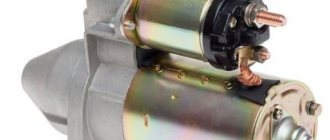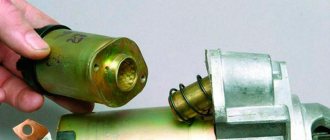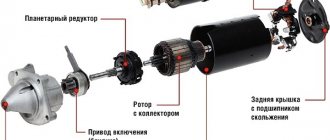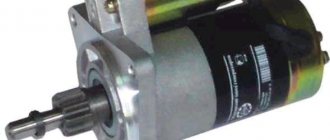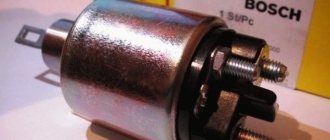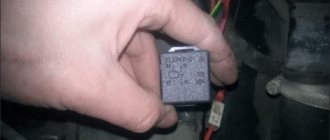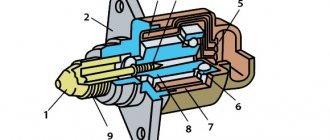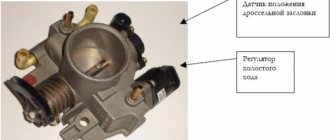02.02.2022 6 708 VAZ 2106
Author: Ivan Baranov
As with any vehicle, on the VAZ 2106 the starter is used to start the engine. If it is broken, it will be difficult to start the car. The article lists common malfunctions of the device and gives instructions on how to remove and repair it.
[Hide]
If the starter does not click or turn, what should the owner of a VAZ-2106 do in such a situation?
There can be many reasons for this problem. The simplest and most common is a battery that is grounded to zero. Recognizing the source of the problem in this case is not difficult. You just need to turn on the headlights. If they do not light up, it means the battery is completely discharged. In this case, you can start it “from the pusher” or ask your neighbors in the garage for a “light.” By the way, the headlights can shine at full intensity. That is, the battery is not completely dead, but the starter does not have enough energy. In this case, the retractor, if everything is in order with it, will make itself felt with a click.
If the battery is charged normally, then you need to continue searching for the source of the problem. We check the integrity of the fuses. If everything is in order here, we look further. By the way, the fault may well be in the ignition switch itself. To check this version, you should carry out a simple manipulation. In particular, you need to try to start the car directly by connecting the necessary wires to each other. If after such manipulation the starter comes to life, it means that the problem is really in the lock, and it should be replaced.
However, before doing this, also check the ignition contact group - it is quite possible that a break has occurred there.
Next, carefully inspect the wiring for breaks. If everything is in order here, then we continue the search. The absence of clicks from the solenoid relay may indicate:
- contact between the rotor “mass” and the positive charge of the stator;
- jammed bushing or shaft of the electric motor.
Without removing the starter, it will not be possible to determine the exact cause. It is quite possible that the absence of clicks is due to the short circuit of the rotor or stator winding. To understand the reason, in any case, you will need to remove the starter and disassemble it.
After this, carefully inspect the retractor terminals. It is likely that they need cleaning (or replacement) after which the problem disappears. If this procedure does not help, check the relay winding. The presence of a malfunction will be indicated to you by a characteristic burning smell. The problem can also be caused by a loose fit between the brushes and the commutator, or too much wear on the commutator. It is quite possible that you just need to replace the retractor.
One point is worth noting - if you have already disassembled the starter, found a specific malfunction, and fixed it, then still conduct a visual inspection of the entire device. This kind of preventive maintenance is extremely useful in preventing future malfunctions. If you see that a part is clearly reaching the end of its service life, replace it immediately. This will eliminate the need to disassemble the starter again after some time. That is, in this case you are doing a kind of prevention.
In conclusion, I would like to note one more point. There are often situations when the retractor clicks, but the starter still does not start the engine. There are many more possible reasons here. However, it also happens that after turning the key there is no reaction at all. Let us list once again all the most typical causes of this problem, both with and without retractor clicks:
- discharged battery;
- loosening the tightening of the tips;
- mass short circuit;
- oxidation of terminals or terminals on the battery;
- brushes worn out or stuck;
- burnt out collector;
- slipping of the freewheel;
- damage to gear teeth;
- bushings that have exhausted their service life;
- egnition lock;
- relay malfunction.
Signaling
This useful feature sometimes brings significant problems. It is difficult to determine why it failed, unless it is a dead battery. If the car does not respond to the ignition key, but you were able to get into it, check the fuel pump, starter and ignition lock. To do this, find the wires leading from the standard wiring to the signaling unit. If you see that the standard wire is divided into two parts and alarm wires are attached to it, congratulations! You found the reason
and it is blocked. To make the car start, disconnect the wires and connect the ends of the header. Ready! We wish you successful roads and no breaking down cars!
The starter in a modern car performs the function of starting the internal combustion engine. In different cars, the power of this unit will accordingly be different. Gasoline engines are usually started with a starter that has 3 kW. It consists of a brush, a bendix, an electric motor, and a retractor relay. Electric motors contain special cores and windings. With the help of Bendix, rotation is transmitted to the crankshaft from the electric motor. But the function of the brushes is to increase the power of the electric motor. Thus, the starter is a very important part of the vehicle.
The starter starts when the driver turns the ignition key. If this does not happen, it means that there is some kind of malfunction. There are several reasons why the starter does not work. We will analyze them all. But in order to find a breakdown in a short time, you need to know how the starter and engine starting system work. Today, many companies provide starter repair services, and for a small fee. Sometimes it is better to trust the repair of your car to professionals, especially if the driver has very little experience in this matter. The main reason why the starter will not start is the battery is discharged. There is a high probability that this is exactly the case when the car “sleeps” in the open air. Batteries that have been running for a long time will drain quickly in cold weather. Therefore, you need to monitor whether there is a charge in the battery (photo 1).
Another reason: starter malfunction. If no sounds are heard at all when turning the key, this means that no power is supplied to the rotor winding of the unit at all. It may also be that the solenoid relay that closes the power contacts has failed, or that the brushes have worn out. In any case, it is necessary to disassemble the mechanism. Replacing the starter is very rare, because it is easy to repair. Another starter is installed if the housing is cracked or destroyed. If after disassembling the starter it is clear that there is no voltage supplied to the windings, then you need to replace the solenoid relay and the device will work. Experts also recommend looking under the ignition distribution cover and making sure there is no condensation under it (photo 2).
The reason may also be in the ignition switch. You need to see if the lights and instruments on the dashboard light up after turning the key. If not, then the car needs to be taken to a car service center. But if the car owner understands electrics, he can independently find out where the break occurred. In rare cases, the steering lock may be broken. Then the car won't start, although all the instruments work. There is also no need to install an alarm relay on the ignition relay. While driving, this structure may become loose, and the car owner will be left without an alarm and ignition (photo 3).
The problem could also be due to the wiring. The car will not start due to any loose or broken wiring. A common case is when the wire on the traction relay breaks. Then the starter will not respond to the ignition key at all. In this case, it is enough to clean the starter coins, which supply the current so necessary for the starter to spin (photo 4).
There may be problems with the wires from the so-called contact group. They are located under the steering column trim. If the driver is not particularly knowledgeable about this, then it is better to let a specialist delve into the wiring. The car also has a fuse that controls the ignition. We need to check, maybe it was he who burned out. You also need to make sure that the lever is moved to position P. Often the starter does not work precisely because of this (photo 5).
We often hear complaints from vehicle owners that the starter does not respond to turning the ignition key. This situation is typical for the cold season, but can also happen in the summer. Its unpredictability lies in the fact that it is impossible to predict exactly when the car will start, and whether it will start at all. In any case, there is no reason to panic, since such a problem is easily fixed.
Car starter: main purpose
Sooner or later, every car owner, regardless of its make and model, has to face the problem that his vehicle refuses to start. The first thing, naturally, is to check the fuel level, battery charge, and electronics. If all this does not cause any complaints and doubts about serviceability, then most likely the problem is in the starter. After all, successful engine starting depends on it.
Currently, as a rule, relays 35.3708 with an end-mounted collector are installed on cars of this model.
However, on some copies of the VAZ 2106, starters made in Germany or Belarus may be installed, since they can be interchanged with starter 35.3708.
At an earlier time, approximately in the 70-80s, the ST-221 starter was also installed.
Problems with the ignition switch
How to make a start button instead of an ignition key in a car with your own hands. How to connect the starter
If the car does not start and the starter does not turn on a charged battery, then perhaps the fault lies in the ignition switch. Several contacts are closed inside it, controlling the operation of the electrical systems necessary to start the engine. The ignition switch itself is connected to the lock cylinder using a shaft or lever and can be in one of the following positions:
- Everything is turned off.
- Ventilation, radio and interior lighting and some other non-propulsion systems are energized.
- The engine control module is connected to power.
- Starter relay is closed.
This is a very general description of how the lock works. The purpose of the key positions and their markings largely depend on the make of the car, year of manufacture and model.
Wear of relay contacts, overheating of the device, weakening of springs - any of these reasons can lead to failure of the unit. While driving, poor contacts in the ignition switch can cut off power to the engine, which is much more dangerous than the absence of an uncertain start of the engine.
The problem may also lie in the lock-key pair itself. Over the course of a year, the lock accepts and releases the key thousands of times; heavy key fobs add load to the cylinders. Over time, the assembly deteriorates to the point that the old key may fall out of the lock or lose its ability to disengage the lock. It is possible that it is impossible to turn on the ignition with a new key, since the pair has not been used before.
Starter solenoid relay
The design of the relay in the starter of a VAZ 2106 car is considered to be quite simple, and every even slightly enthusiastic motorist can easily disassemble and assemble it independently. However, removing and then reinstalling the solenoid relay turns out to be an impossible task for many. However, professionals can handle this without difficulty.
If you suspect that the solenoid relay in your car is broken, you should definitely check it. The relay in the VAZ 2106, as in other car models, works as an electromagnet. In order to check its serviceability, you need to close it with a metal object, for example, a screwdriver. If the starter starts to rotate, then the fault is indeed in the relay. If you hear clicks from the retractor relay, but the starter does not start to rotate, then you need to look for the breakdown in it itself.
The car stopped responding to the ignition key
A car breakdown is always an unpleasant surprise, but if your car does not respond to the ignition key, there is no need to panic; perhaps the problem can be fixed without the help of a car service center. First, rule out the simplest reasons that you might have overlooked. These include: lack of fuel, low battery, blown fuse and basic contamination of the terminals. Also, the ignition may be blocked if you forget to turn off the anti-theft system.
What can you do yourself?
Checking the above errors is quite simple - the fuel level will be shown by the indicator on the panel, but you can determine the battery charge using a multimeter. So, the normal voltage when the engine is not running (after all, you cannot start it) is in the range of 12.5 - 13.0 V. And if the device readings show less than 11.8-12.0 - your battery is definitely discharged and you need to find an opportunity start the engine from another car.
If the car does not start, check the presence of gasoline and the condition of the battery and fuses.
To check fuses, you can use a visual inspection, since most often they have a transparent body. A blown fuse will have a broken wire with melted edges
Fuses with an opaque body can be checked for voltage with a multimeter. In some cases, problems with ignition arise due to mechanical factors, and therefore, when answering the question of why the ignition key does not turn in the lock, you should pay attention to the following points:
Ignition switch lubricant WD40
Inspect the lock for contamination. For cleaning, you can use the universal WD40 product, which is carefully injected into the lock hole.
Check the key for deformation; perhaps it was accidentally bent and needs to be straightened. At sub-zero temperatures, be sure to check if the lock is frozen. You can warm it up with a regular hairdryer.
In cars equipped with automatic transmission, it is often impossible to turn the key if the gear selector is not in neutral or on the brake.
If there are no obvious reasons, the steering rack may be locked. To remove it, try turning the key while smoothly turning the steering wheel (do not use excessive force so as not to break or bend it and the locking device).
When will a master be needed?
If the ignition key does not turn and is stuck, you will most likely have to remove the lock. This can occur as a result of wear on the lamellas of the locking device, which is often indicated by regular jamming of the key. To remove the key, you can use a syringe to inject WD40 inside and carefully try to turn it to its original position. In the future, to solve the main problem, many motorists remove the damaged slats. They do this to save money, since installing a new lock is quite expensive. It is not always easy to disassemble a lock on your own, and considering that there are technologies for restoring slats, in the absence of experience, it is better to invite a specialist.
Ignition switch repair
Mechanical damage also includes a faulty spring, as a result of which the ignition key does not return to its original position. This may damage the starter. To eliminate such a malfunction, you will need to replace the lock contact group with a new one, and you also cannot do without a car mechanic.
And in conclusion, one piece of advice. When diagnosing the cause of a faulty ignition switch, use your judgment, even if you are in a hurry. This is the basis of success, because applying force without involving the mind will only do harm.
Starter relay repair
Repairing the starter relay seems to be a very troublesome and often hopeless task, so an easier option would be to simply buy a new one and replace it. This is due to the fact that, worrying about the reliability of their product, most manufacturers produce non-separable starter relays for both VAZ 2106 cars and other brands of cars. However, there are still models that are not difficult to disassemble and repair.
There are several main breakdowns that you may encounter while working with the starter relay of a VAZ 2106 car. The first is wear of the mechanical wire, the second is the burning of nickels, and the third is a short circuit. Each of these failures can be determined by disassembling the starter relay.
You can also use a special tester to check the serviceability of the starter relay, which does a good job of determining a short circuit in the circuit.
If, after disassembling this part, you find scratches or burrs on it, they need to be removed using sandpaper. Parts that have significant wear can be corrected using gaskets, but this does not always bring the desired result. Sometimes it will be more effective to replace them with new ones. Damaged insulation should also be replaced with a new one. Collectors with worn or loose plates cannot be repaired and must be replaced.
If there are noticeable breaks or damage to the thread, then it is worth cutting a new one or using so-called screws.
If there are faults in the excitation windings, you should disassemble the housing, remove the screws securing the tips and terminals. The coils must be thoroughly dried and impregnated with insulating varnish. Contacts that have oxidized must be cleaned, and those that have been welded must be replaced with new ones.
The bushings on the starter of a VAZ 2106 car are changed if they have significant wear or scuff marks are found on them. To determine the wear of these same bushings, you need to measure the roller clearance. If it is more than 0.2 mm, then the bushings are worn out and must be replaced.
Assembling the starter parts of a VAZ 2106 car is carried out in the reverse order to the one in which you disassembled it.
When carrying out all the above work, one should not forget about safety precautions and under no circumstances violate them.
A starter is an element of a vehicle - an electric motor that has 4 poles. He starts the engine in the car. As for the principle of its operation, it is based on the fact that it transmits the initial stroke to the engine crankshaft. Thanks to the 4 brushes of this device, the level of power and torque increases. Of course, if the starter is faulty, the engine cannot be started.
Security system activated
Why doesn't the starter turn on a hot engine? And we know the reason
Modern cars are equipped with an immobilizer. This means that in order to start the engine, the on-board computer requires a response from a transponder or chip in the key containing a specific code.
There are millions of variations of codes, and if the key is damaged or contains an incorrect code, the security system will prevent the ignition from turning on or block the engine.
Usually such problems are indicated by a message on the dashboard. If the sensor detects an incorrect code in the key, the car, as a rule, reports its reaction to this with additional signals from the headlights or turn signals. There are two possible breakdowns in this case:
- The car did not recognize the key.
- The security system is faulty.
Issues such as a broken immobilizer antenna or broken wiring surrounding the lock cylinder may prevent the code from being read. There can be many reasons why the on-board computer does not recognize the chip. The simplest one lies in the fact that some keys operate only on battery power, without which the chip is not recognized by the on-board computer.
VAZ 2106 starter circuit
First, let's take a closer look at the VAZ 2106 starter circuit.
Deciphering the VAZ 2106 starter circuit:
- — drive side cover;
- — retaining ring;
- — restrictive ring;
- — drive gear;
- — overrunning clutch;
- - drive ring;
- — rubber plug;
- — drive lever;
- — relay anchor;
- — holding winding of the traction relay;
- — pull-in winding of the traction relay;
- — relay coupling bolt;
- — contact plate;
- — relay cover;
- — contact bolts;
- — collector;
- - brush;
- - armature shaft bushing;
- - cover on the collector side;
- — casing;
- — shunt coil of the stator winding;
- - frame;
- — stator pole fastening screw;
- - anchor;
- — armature winding;
- - intermediate ring.
VAZ 2106 starter connection diagram
Deciphering the VAZ 2106 starter connection diagram:
- — generator;
- - accumulator battery;
- — starter;
- ignition switch;
P1 - pull-in winding of the traction relay;
P2 - holding winding of the traction relay.
Key - ignition - Great Encyclopedia of Oil and Gas, article, page 2
Key - ignition
The CL warning lamp is powered by battery current when the engine is not running and the ignition key is turned on. The current path is shown by dotted arrows. When the lamp lights up, it indicates that the battery is low. During operation of the generator, when the voltage in the winding of the PC702 relay is 7 - 7 5 V, the contacts open and the signal lamp goes out.
To emergency stop the gas engine compressor, it is necessary to close the fuel gas valve on the engine and turn the ignition key to the Stop position (turn off the ignition), turn on the oil pump and turn it off after 20 minutes, unload the compressor cylinders, manually turn the lubricator and crankshaft.
So, making sure that the gearshift lever is in the neutral position, turn the ignition key (Fig. 13) clockwise until the starter operates. As soon as the engine starts, the ignition key should be released immediately.
The oil line contains a green indicator light on the pressure gauge, which lights up after the ignition key is inserted into the lock. When the engine is running with a working lubrication system, the light should go out.
Remember your first night trip in a newly purchased car: you had difficulty inserting the ignition key, in an attempt to switch from high beam to low beam, the wipers constantly turned on, setting up the radio turned out to be simply an insoluble task. Nothing happened automatically, without a hitch; I had to think about every action.
To avoid allowing unauthorized persons to drive the vehicle, the driver should not leave the vehicle with the engine running or the ignition key left in the lock unattended.
If the ignition switch is working properly and the indicator lamp 9 lights up fully when it is connected to terminal 50 of the ignition switch in the Start position of the ignition key, then you should check the starter relay. It must be disassembled and the contact disk and contacts cleaned.
Before filling, the filling operator must conduct a thorough inspection of the outer surface and fittings of the tanker, check the presence of residual pressure in the tank tank and the suitability of the gas in it for the purpose of the tank, and take the ignition key from the driver.
The ignition system (Fig. 12) consists of a battery 4 and a generator 8, an ignition coil 14 with a variator 17, a breaker 9 with a capacitor 10, a distributor 18, spark plugs /, an ignition key 2 and low and high voltage wires.
To calibrate the indicator scale, first supply it with power directly from the battery and use trimming resistor R4 to set the microammeter needle to zero. Then, with the ignition key turned off (in order to prevent the flow of uncontrolled battery current), the positive terminal of the battery is connected through a powerful (about 60 W) resistor with a resistance of 2 4 Ohms to the car body and the tuning resistor Y7 is set to the 5 A mark. After calibration, the positive terminal of the indicator power supply is connected to the positive wire of the vehicle's on-board electrical network.
So, making sure that the gearshift lever is in the neutral position, turn the ignition key (Fig. 13) clockwise until the starter operates. As soon as the engine starts, the ignition key should be released immediately.
The regulator works as follows. After turning on the power with the BI switch (ignition key), while the engine is running at low speeds and the generator voltage is less than the specified level (see Table 6), determined by the position of the potentiometer RZ slider and the stabilization voltage of the zener diode D, the latter is locked. Transistor T is also locked, and transistors Tu and G3 are unlocked. The excitation winding of the generator is connected through diode Dz and open transistor T3 to the positive pole of the battery E, and the generator receives full excitation. As a result, the generator voltage increases as the engine speed increases or its load decreases. When the generator voltage reaches a given level, the zener diode D ] and transistor T are unlocked, and transistors G2 and G3 are locked. The field winding is disconnected from the power source, and the generator voltage begins to decrease.
Let us, however, continue to consider the connection diagram. The remaining free end of the left electromagnet coil is connected through the ignition key to the positive pole of the battery. The negative terminal of the battery is connected to ground.
Pages: 1 2 3 4
VAZ 2106 starter does not start
What signs indicate that the starter needs to be repaired or is time to be replaced? Why does the starter sometimes not start?
These questions have their own answers:
- The relay functions without problems. However, the anchor does not respond or makes slow rotational movements. Solution ! As a rule, this is due to burning of the collector. It is also necessary to pay attention to the winding. It must be complete. It is also possible that the relay fastening elements are loose, there is a short circuit in the commutator, the brushes are stuck or have become completely unsuitable for further use. However, the reason may lie in a discharged battery.
- The starter responds, but the armature relays do not function. Solution ! Often the whole point is that the anchor is stuck. In this case, it is worth checking how the tips are fixed. Is there a short to ground and what is the condition of the wiring?
- The armature rotates, but problems arise with the crankshaft. Solution ! It's worth checking the buffer spring. Most likely it's broken. Some components of the coupling may be damaged.
- Powerful noises are heard. This is often the result of damaged bushings and gears.
- In turn, the starter turns, but does not start. You need to take a closer look at the return spring. The device may also be skewed. It is also possible that the relay and drive handle are jammed.
The battery is low
On a VAZ 2101, when the ignition is turned on, the starter does not engage
The vehicle's power supply system largely depends on the health of the battery. To keep it in working order, you must comply with a number of requirements and instructions. If, for some reason, the battery was not taken care of, then sooner or later such negligent attitude will come back to haunt the owner.
The most pronounced symptoms of a faulty battery are:
- low brightness of running lights;
- sound signal attenuation;
- presence of a red/white indicator on the battery cover;
- deflection of the on-board ammeter needle towards the charge when the starter circuit is closed;
- presence of sulfation at the battery terminals.
All these signs, one way or another, indicate that the battery needs diagnostics. First, you should check the level and density of the electrolyte. After this, the battery must be charged using a charger. If the battery is old, charging should be done at extremely low charging current values.
During this procedure, the battery can caps must be removed. During the entire charging time, you must ensure that the battery does not self-discharge. It happens that during charging one or more cans begin to “boil” before the rest. This phenomenon indicates that the battery, due to improper care, has exhausted its resource.
Replacing the VAZ 2106 starter
The most common reason why a six starter becomes faulty is the failure of the retractor relay with which it is equipped. That is why, when turning the key, the driver will hear a characteristic click. Consequently, the engine will not start in this case.
True, sometimes it is necessary to completely replace the starter. But first you need to dismantle the old starter. To do this, use the key to “thirteen”.
Replacing the starter consists of the following steps:
- We remove the battery.
- Then you need to find the fasteners.
- Then you need to unscrew the 2 bolts.
Unscrew the bolts
Then you should pull the starter and move it towards the right. So it will move away from its previous position and shift to the right side.
- Next, you need to lift the left side of the starter and turn it upside down. It is pulled up all the way.
- This element of the vehicle should be lifted until the wiring located at the rear of the starter becomes accessible and the wires can be removed.
- There are 2 wires at the back. One of them is fixed using a standard nut, which initially needs to be unscrewed.
- A simple plug serves as the second nut. It needs to be moved to the side. It can be dismantled without much effort.
- Once the starter is free, it can be easily removed.
Unscrew the power cable nut
As for installing a new starter, it is carried out in the reverse order. This procedure will not take much time. It is recommended that you perform these steps in a specific sequence.
In other words, you first need to connect the wires to the starter, and only then install it in its original place. At the same time, the price of a new starter for a six ranges from 2 to 4 thousand rubles. It all depends on the manufacturer and modification of the device itself.
The car does not respond to the ignition key
Good mood? Your car knows how to ruin it seriously and for a long time. Of course, unless you are an optimist to the core. Imagine: approaching a car, whistling a song. Sit down. Insert the key. And that's it - the car does not respond to the ignition key. There are a lot of reasons. Let’s look at the main ones and try to save your day from inevitable worries.
Battery
Primitive, but true. Rule out this reason before others, because it’s a shame to give up your hard-earned money for diagnosing a dead battery. Catch the silence in the cabin and listen - if at the moment you turn the key the relay clicks, the unit may be dead. The click is clearly heard, don’t be afraid, you definitely won’t miss it. A voltmeter will certainly help you make sure, however, not every driver has one. If the device is missing, remove the terminals and strike each other. A flickering spark will indicate that the battery is working.
It is important to understand that striking terminals is unsafe. Therefore, you either don’t produce it at all, or don’t do it in front of the firefighters
You won't get a pat on the head for this.
Another reason is oxidation or contamination of the terminals. Eliminates on its own. If there is a clear green or gray coating, remove the terminals and clean with a wire brush or sandpaper.
Circuit breakers
Every self-respecting car considers it a personal duty to provide the owner with at least one blown fuse once every five years. Don’t be upset, replacing a deceased comrade is as easy as shelling pears. Look in the manual for the location of the fuses and use pliers to remove the culprit responsible for the ignition. If the inside of the bridge is blackened, throw away the part and buy a new one. The price will not exceed 100 rubles.
Turning off the ignition
The easy reasons are over, let's move on to the sad ones. They are sad because they can only be repaired by electrical enthusiasts. The rest will have to walk to the car service on a tow truck or rope. Here who is closer?
There are two ways to check the functionality of the ignition switch:
- insert the key into the lock and turn it to the second position. Wait a few seconds: if the red lights on the dashboard come on, everything is fine with turning off the ignition. Otherwise, it is faulty;
- try to start the engine and turn on the headlights at the same time. If they dim, there is no need to worry - turning off the ignition is working.
Starter
Call a friend to help check the starter. Follow the instructions:
Connect the tester to the wire from the starter
At the same time, ask a friend to start the engine.
Pay attention to the device readings. If current is flowing, but the starter is acting like a dead baboon, it will have to be replaced.
To avoid the same fate as the starter, work with insulating gloves.
Ignition
If the previous steps did not help, proceed to checking the ignition. The most common problem occurs due to moisture accumulation in the distribution cap. Do the following:
- Remove the cover and inspect for condensation.
- If there is one, wipe with a dry cloth. Before wiping, check the lid for cracks - if there are any, just throw it away and buy a new one.
If everything is fine with the cover, check the wires for electrical conductivity. Bring the tester to the insulation and wait for a successful outcome. It will be so if you do not detect current: with normal wires, the insulation will not allow it to pass through.
Signaling
This useful feature sometimes brings significant problems. It is difficult to determine why it failed, unless it is a dead battery. If the car does not respond to the ignition key, but you were able to get into it, check the fuel pump, starter and ignition lock. To do this, find the wires leading from the standard wiring to the signaling unit. If you see that the standard wire is divided into two parts and alarm wires are attached to it, congratulations! You found the reason and it is blocked. To make the car start, disconnect the wires and connect the ends of the header. Ready! We wish you successful roads and no breaking down cars!
Starter relay VAZ 2106
The structural structure, which has a VAZ 2106 starter solenoid relay, has a complex structure. At the same time, many drivers who more or less understand the details of the “six” can disassemble it with their own hands.
As for subsequent assembly, not every motorist can cope with this task. In this case, it is best to trust the professionals.
If you think the relay needs to be replaced but are not sure, it needs to be thoroughly inspected. It is noteworthy that the relay in the six functions similarly to other elements installed in various vehicle models. That is, it performs the functions of an electromagnet.
To check its condition, it is closed with a metal object. For example, you can use a screwdriver. If the starter begins to make rotational movements, then the starter relay will indeed need to be repaired. When clicks are heard from the retractor-type relay, but the starter rotates, then it is the latter that is broken.
Why does the starter relay stop working? There are several answers to this question. The problem may be due to outdated parts (the material deteriorates over time). The winding also . In this case, the reason may lie in the combustion of nickels , which are located in the internal part of the relay itself.
However, for a novice driver who has not previously done repairs, it is necessary to find out where the VAZ starter relay is located. If he does not want to waste his time and think about how to disassemble this part (by the way, there is a visual diagram of the relay, and you can buy all the spare parts yourself), then he can turn to professionals. They will not only disassemble this part, but will also connect the relay. In this case the price will be minimal.
Starter solenoid relay
If the starter is safely removed from under the hood, it must be cleaned. Contaminants are removed from it. As for oxidized contacts, they are processed using sandpaper.
Diagnostics of the starter solenoid relay:
- The starter is located near the battery. In this case, 2 electrical wires are prepared, which must be of sufficient length. Wires intended for “lighting” are ideal. They are equipped with so-called “crocodiles”.
- Initially, the positive terminal is connected to the battery (the corresponding output of the solenoid relay) via one electrical wire.
- Then the other wire is connected to the battery terminal, which has a negative value.
- Finally, you need to touch the free unoccupied end of the electrical wire with a negative value. This contact must take place with the starter housing. Further actions will depend on the results obtained.
If during the connection process the solenoid relay makes a quick and distinct click, then it is operating normally. When the part does not show any signs of “life,” the solenoid relay must be repaired or completely replaced.
How it all works
To figure out where to look for the cause, let's look at the circuit diagram for connecting the starter, which is quite simple.
Since the starter is a power electric motor, when turned on, it consumes a lot of energy, the source of which is the battery.
Starter connection diagram
To minimize resistance losses, the “positive” power wire has a sufficiently large cross-section and is pulled directly from the battery to the solenoid relay. The “minus” is the engine itself.
Theoretically, it turns out that electricity is supplied to the starter constantly. But there is a gap in this circuit that allows the electric motor to be turned on only at the right moment. And this gap was made in the solenoid relay. The wire from the battery goes to one of the terminals of this relay (there are three in total). The second terminal is connected via a bus to the brush assembly of the electric motor and in the normal state these two terminals are open. A wire going to the ignition switch is connected to the third terminal, and another wire is laid from this lock - to the battery.
Starter device
The task of the retractor relay is to close the first two terminals, as well as move the bendix with the gear to engage the flywheel.
The circuit works like this: in the normal state, the armature of the retractor relay, due to the action of the spring, is in a position where the power supply terminals of the electric motor are open and the bendix is disengaged.
When turning the key, the driver closes the power circuit of the retractor relay. Voltage is applied to its winding, resulting in a magnetic field acting on the armature, which leads to its retraction. At the same time, he pulls the bendix, inserting it into its gears, and when he reaches the stop, he closes the power supply terminals. engine (nickels). As a result, the circuit break is eliminated and energy is supplied to the engine - it starts working.
The described malfunction - audible clicks without the engine firing - indicates that for some reason voltage is not supplied to the second node.
Why is there no sound from the starter when I turn the key?
The design of the starter of any vehicle is a powerful electric motor, the power source of which is a car battery. Such an element is characterized by both mechanical damage caused by improper operation and natural wear of its component parts, as well as malfunctions associated with its electrical part. When no changes occur in the starting system of the power unit after turning the ignition key, the starter is silent, and its retractor relay does not make characteristic clicks, the following diagnostic measures must be carried out:
- Measure the power supply voltage
- Check the condition of the contacts in the ignition switch
- Perform a performance test on the solenoid relay
- Carry out diagnostics of the starter and its bendix
The condition of the lock contacts is checked by turning on the ignition using the key. The lighting of the indicators on the instrument panel is evidence of the working condition of the ignition switch, but if this does not happen, it is necessary to begin troubleshooting.
To check the battery, simply disconnect the negative terminal and measure the voltage of the power source using a voltmeter. If it is within 9V, the battery needs to be recharged, since its capacity is not enough to start the engine.
Clearly audible characteristic clicks in the area where the starter is located when starting the engine are produced by its traction relay. Note that the relay can click either when there is a fault in it or the starter itself, or when the power source is discharged, while the indicators on the instrument panel glow dimly or go out completely.
Dead battery
A dead battery is the most common reason why the starter will not engage when you turn the ignition key. While driving, the battery is constantly charged by the generator. If operating conditions do not allow the battery to be recharged sufficiently, sooner or later it will lose the ability to start the engine or provide power to other electrical components. The battery may die suddenly due to the following reasons:
- Headlights or other electrical equipment were turned on for too long while the vehicle was turned off.
- There is a leak in the on-board circuit.
- Moisture constantly entered the terminals.
- The battery life has expired.
Sudden failure is completely normal behavior for batteries, but in some cases you can notice signals preceding such an outcome. A sign that it’s time for the battery to undergo maintenance or it’s time to think about replacing it is difficulties with a cold start. Easy ways to diagnose a dying or dead battery:
- When the windshield wipers are on, they work slower than usual.
- The interior light dims noticeably when the engine is started.
The average service life of a car battery is 4 years. If the engine is fresh, but completely discharged, you can try to start it with outside help and let the car run for a while.
